Japan Festivals – Must-See Cultural Events Throughout the Year
Japan is a land of rich traditions, vibrant culture, and deep-rooted spirituality, and nothing showcases this more vividly than the celebrated Japan festivals. Throughout the year, across every season, towns and cities burst into color, music, dance, and ritual as locals and visitors alike come together to celebrate a wide array of events. These Japan festivals are not just occasions for entertainment—they are a window into the country’s history, beliefs, and community spirit.
Whether you’re visiting Japan for the first time or returning for another cultural adventure, this comprehensive guide will help you navigate the most iconic and must-see Japan festivals throughout the year, providing practical tips and essential highlights.
Why Japan Festivals Are a Unique Cultural Experience
Japan festivals are deeply intertwined with the country’s spiritual, agricultural, and historical heritage. These celebrations reflect a unique balance of solemn rituals, community participation, and joyful entertainment. Attending a festival in Japan offers far more than sightseeing—it provides an immersive experience where you can taste local delicacies, witness traditional performances, and engage with centuries-old customs.
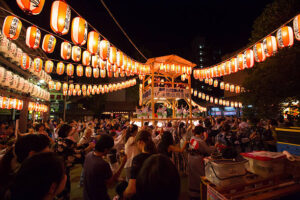
🌸 Spring Festivals (March – May)
1. Cherry Blossom (Hanami) Festivals
Hanami, or cherry blossom viewing, is one of the most beloved Japan festivals, celebrated throughout March and April.
Highlights:
-
Picnics under blooming cherry trees: Families and friends gather for hanami parties.
-
Night Illuminations (Yozakura): Trees lit up at night create a magical atmosphere.
-
Popular Spots: Ueno Park in Tokyo, Maruyama Park in Kyoto, and Hirosaki Castle Park.
Insider Tip:
Visit early in the morning or on weekdays to avoid crowds and enjoy peaceful cherry blossom views.
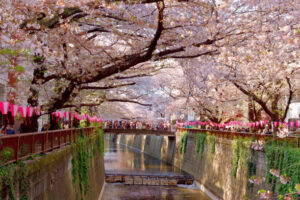
2. Takayama Spring Festival
Held in April, the Takayama Festival is renowned for its beautifully crafted floats and historical significance.
Highlights:
-
Yatai Floats: Elaborate wooden floats decorated with intricate carvings.
-
Traditional Performances: Puppet shows and ceremonial music.
-
Atmosphere: Celebrated in the charming historic town of Takayama.
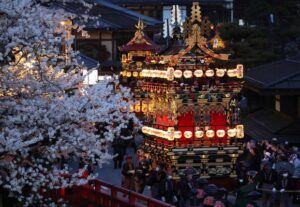
🌞 Summer Festivals (June – August)
3. Gion Matsuri (Kyoto – July)
One of the most iconic Japan festivals, Gion Matsuri stretches throughout July.
Highlights:
-
Yamaboko Junko Parade: Extravagantly decorated floats parading through Kyoto streets.
-
Cultural Ceremonies: Shinto rituals invoking prosperity and good health.
-
Local Food Stalls: Seasonal festival snacks and sweets.

4. Awa Odori (Tokushima – August)
Awa Odori is a lively dance festival celebrated in Tokushima.
Highlights:
-
Traditional Dance: Groups of dancers in colorful attire performing rhythmic movements.
-
Music Accompaniment: Shamisen, taiko drums, and flutes.
-
Participation: Visitors are encouraged to join in the fun.
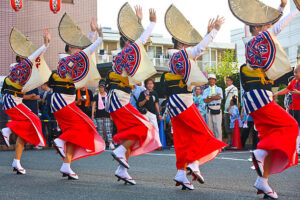
5. Nebuta Matsuri (Aomori – August)
This visually spectacular Japan festival is famous for its illuminated floats.
Highlights:
-
Large Lantern Floats: Depicting warriors, historical scenes, and mythical creatures.
-
Festive Atmosphere: Lively music, chanting, and vibrant processions.
-
Cultural Insight: Reflects local legends and traditions.
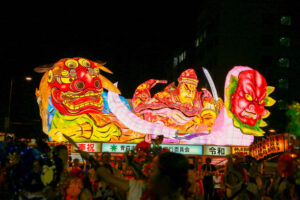
🍁 Autumn Festivals (September – November)
6. Jidai Matsuri (Kyoto – October)
Jidai Matsuri celebrates Kyoto’s historical legacy.
Highlights:
-
Historical Costume Parade: Participants dress in period costumes representing different eras of Japanese history.
-
Kyoto Imperial Palace: The festival starts here and proceeds through city streets.
-
Cultural Significance: A living history of Japan’s past.
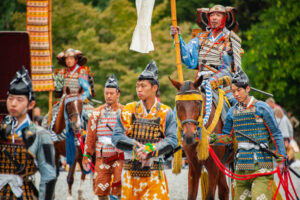
7. Kurama Fire Festival (Kyoto – October)
An intense and mystical Japan festival where fire takes center stage.
Highlights:
-
Torch Processions: Locals carry massive torches up Kurama mountain.
-
Spiritual Rituals: Shinto ceremonies to honor mountain spirits.
-
Atmosphere: Dark, smoky, and ancient.
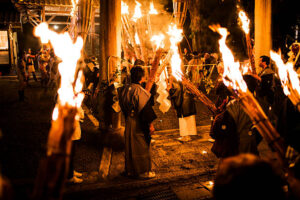
❄️ Winter Festivals (December – February)
8. Sapporo Snow Festival (Hokkaido – February)
One of the world’s largest Japan festivals, celebrated in snowy northern Japan.
Highlights:
-
Snow and Ice Sculptures: Giant creations crafted with incredible detail.
-
Illuminations: Stunning night displays.
-
Local Specialties: Sample Hokkaido’s famous seafood and ramen.
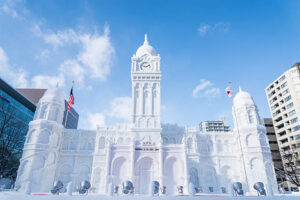
9. Otaru Snow Light Path Festival (Hokkaido – February)
This charming winter Japan festival features candle-lit streets.
Highlights:
-
Romantic Atmosphere: Hundreds of small snow lanterns illuminate the canal paths.
-
Local Art: Ice sculptures and small exhibitions.
-
Cultural Significance: Celebrates winter’s quiet beauty.
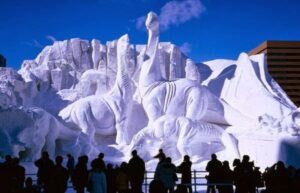
🌼 Unique Regional Festivals
10. Kishiwada Danjiri Matsuri (Osaka – September)
A high-energy Japan festival known for its float racing.
Highlights:
-
Danjiri Floats: Massive wooden carts pulled at high speeds through narrow streets.
-
Community Spirit: Entire neighborhoods participate.
-
Excitement: Competitive and thrilling atmosphere.
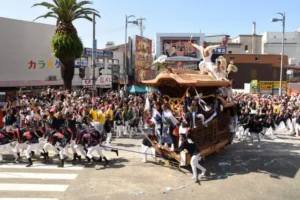
11. Shirakawa-go Doburoku Festival (Gifu – October)
A lesser-known but fascinating Japan festival focusing on traditional sake.
Highlights:
-
Doburoku (Unfiltered Sake): Locals brew and offer homemade sake.
-
Cultural Traditions: Shrine blessings and local folk dances.
-
Historic Village: Set in UNESCO-listed Shirakawa-go village.
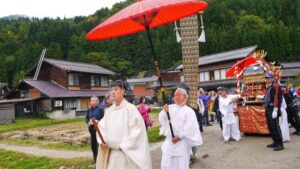
🎎 Festivals Rooted in Spirituality
12. Obon Festival (Mid-August)
Obon is a deeply spiritual Japan festival, honoring ancestors.
Highlights:
-
Bon Odori Dance: Performed by locals in traditional attire.
-
Lantern Floating Ceremony: Guiding spirits back to the afterlife.
-
Family Reunions: People return home for memorial rituals.
13. Setsubun (February 3–4)
Setsubun marks the beginning of spring in Japan.
Highlights:
-
Bean-Throwing Ritual (Mamemaki): Drives away evil spirits.
-
Shrine Ceremonies: Held at temples like Senso-ji in Tokyo.
-
Festive Atmosphere: Seasonal foods like roasted soybeans.
Experience Local Food During Festivals
Japan festivals wouldn’t be complete without their distinctive food culture.
Must-Try Festival Foods:
-
Takoyaki: Octopus-filled balls.
-
Yakitori: Grilled chicken skewers.
-
Kakigori: Shaved ice flavored with syrup.
Practical Tips for Attending Japan Festivals
-
Plan in Advance: Major festivals get crowded—book accommodations early.
-
Respect Tradition: Follow local rules, especially at sacred ceremonies.
-
Cash is King: Most stalls accept only cash.
-
Dress Appropriately: Wear comfortable shoes and yukata during summer festivals.
-
Festival Calendar: Check official websites for exact dates as some follow the lunar calendar.
Sample 3-Day Festival Itinerary in Japan
Day 1: Tokyo
-
Morning: Visit Asakusa and experience Setsubun ceremonies.
-
Afternoon: Explore Senso-ji Temple and shop for festival-themed souvenirs.
-
Evening: Attend local fireworks or seasonal street festival.
Day 2: Kyoto
-
Morning: Visit Gion district and attend the Gion Matsuri events in July.
-
Afternoon: Explore Jidai Matsuri costume parade.
-
Evening: Experience traditional tea ceremonies.
Day 3: Hokkaido
-
Morning: Visit the Sapporo Snow Festival or Otaru Snow Light Path Festival (February).
-
Afternoon: Explore local ice sculptures and enjoy regional winter cuisine.
-
Evening: Relax in a hot spring while reflecting on the festival experience.
Conclusion – Celebrate Japan’s Cultural Heartbeat
The Japan festivals represent the beating heart of the nation’s cultural and historical legacy. Each festival, whether a grand procession, a quiet lantern ceremony, or a lively dance parade, reflects Japan’s deep respect for tradition, community, and seasonal change. These festivals are not just events; they are experiences that connect you to Japan’s past, present, and future.
Immerse yourself in the magic of Japan festivals and let every event, taste, and tradition enrich your journey through this fascinating country.
Follow Us: Instagram